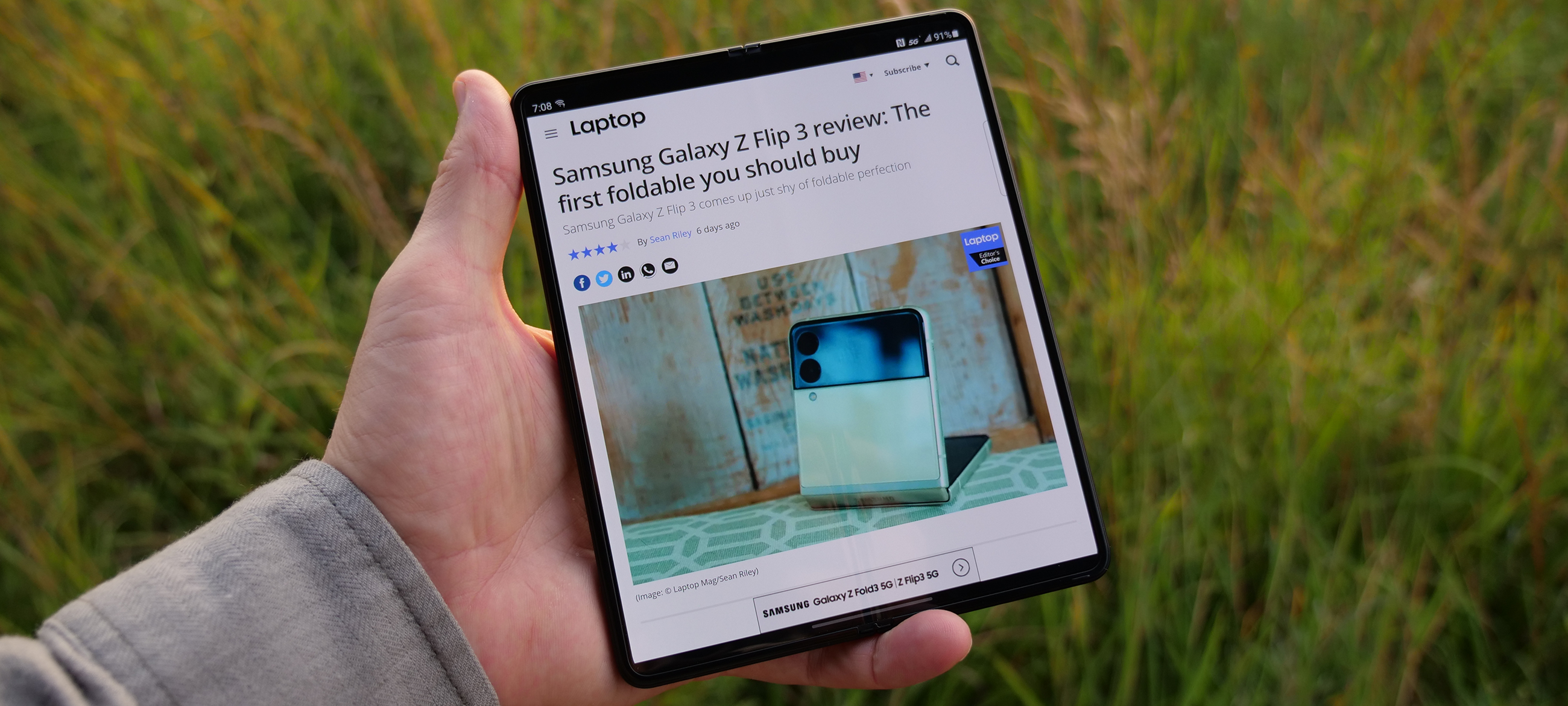Laptop Mag Verdict
The Samsung Galaxy Z Fold 3 fixes some of our biggest concerns with its predecessor with enhanced durability and improvements to the cover display, but it remains too expensive and bulky to recommend for many buyers.
Pros
- +
Unique and useful design
- +
Bright, vivid 120Hz displays
- +
Stellar triple camera array
- +
IPX8 water resistance
- +
S Pen support
Cons
- -
Expensive
- -
Bulky vs. traditional phone
- -
Still lacks dust resistance
Why you can trust Laptop Mag
Price: $1,799
OS: Android 11 with One UI 3.1
Cover Display: 6.2-inch (2,268 x 832) 120Hz Adaptive Super AMOLED
Internal Display: 7.6-inch (2,208 x 1,768) 120Hz Adaptive Super AMOLED
CPU: Qualcomm Snapdragon 888
RAM: 12GB
Rear cameras: 12MP wide (ƒ/1.8); 12MP ultra-wide (f/2.2); 12MP 2x telephoto (f/2.4)
Front cameras: 10MP (f/2.2); 4MP (f/1.8)
Storage: 256 or 512GB
Battery: 7:58/8:48 (cover display(120Hz/60Hz); 6:36/7:53 (internal display (120Hz/60Hz)
Size: 6.2 x 5 x 0.25 inches (open); 6.2 x 2.6 x 0.62 (closed)
Weight: 9.55 ounces
Three generations in, opening the Galaxy Fold remains delightful. It’s gone from cracking open a new book excited at the prospect of what’s inside to dipping back in for a reread of a recent favorite. Particularly coming from the Galaxy Z Fold 2, the changes are primarily conveniences, water resistance at last, and overall improved durability along with the addition of S Pen support for Note fans who may be looking for new options from Samsung.
There are other improvements. The cover display now sports the same 120Hz refresh rate as the internal display and the processor is now the Qualcomm Snapdragon 888, but overall the experience of the device is quite the same — and for the most part that’s just fine. By the same token, some of the same downsides remain; the phone is still bulky in its folded state, despite slimming down a bit.
Pricing also slimmed down a bit to $1,799, but that $200 discount is not as big as many were hoping for with the foldable premium still firmly intact for the Fold, while Galaxy Z Flip 3 buyers were treated to a $450 price drop from the Galaxy Z Flip 5G.
I have no qualms calling the Galaxy Z Fold 3 one of the best phones on the market, but as with its predecessor, there are definitely more asterisks than with a traditional flagship, so read on to see if it’s worth it for you.
Samsung Galaxy Z Fold 3 price and configurations
The Samsung Galaxy Z Fold 3 is available in two configurations for $1,799 or $1,899. Both feature a Snapdragon 888, 12GB of RAM, and 5G support with storage of 256GB or 512GB as the only differentiator.
The 256GB model has three available colors: Phantom Black, Phantom Green or Phantom Silver. The 512GB model makes your decision much easier with Phantom Black as the only option.
Samsung stunned everyone with a $450 price cut to the Galaxy Z Flip 3 versus the Galaxy Z Flip 5G, sadly the Galaxy Z Fold 3 didn’t get the same treatment. The much more modest $200 discount on Fold 3 represents a 10% reduction compared to the roughly 31% on the Z Flip 3. It’s good to see the price moving in the right direction and there are some notable (and costly) upgrades to the Galaxy Z Fold 3 this year, but at $1,799 it is a tough sell at full price.
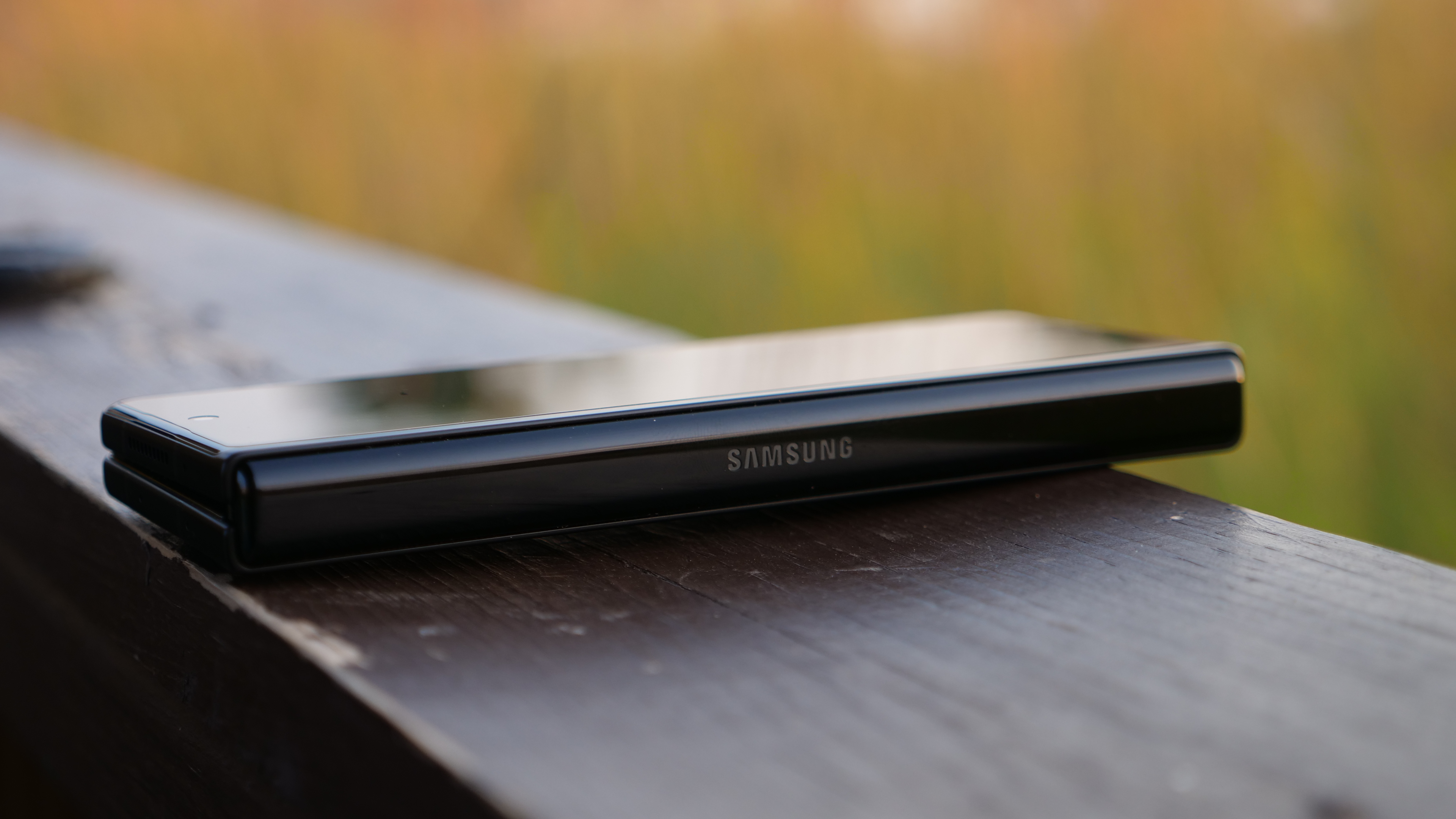
On that note, Samsung does have some solid trade-in offers for the Galaxy Z Fold 3 to bring that price down to a more manageable level. It also allows you to trade up to four phones toward the Galaxy Z Fold 3, which is helpful if you have been hoarding some older phones. This doesn’t change the fact that the Galaxy Z Fold 3 is one of the most expensive phones on the market, but it does help for those that want to take the plunge regardless.
Samsung Galaxy Z Fold 3 design
The Samsung Galaxy Z Fold 3 had an impossible act to follow as the Galaxy Z Fold 2 design was a revelation last year. Like the Galaxy S21 lineup, the Galaxy Z Fold 3 is an incremental update to its predecessor, but the minimal design changes are impactful even if they are mostly invisible.
The biggest upgrade is the addition of IPX8 water resistance. While you may be thinking that you weren’t intending to take a swim with your $1,799 phone (and you shouldn’t), eliminating the concern over a spilled drink, an accidental drop in a bathtub or sink is huge for peace of mind. The phone can withstand up to 30 minutes submerged in five feet of water.
Dust proofing is still non-existent. The hinge renders dust-proofing impossible as there are too many moving parts. The solution on the Galaxy Z Fold 3 remains tiny nylon brushes that essentially sweep the dust out from the hinge if it gets in. That solution held up well on the previous generation of foldables, so while imperfect, it appears to be good enough.
The new “Armor Aluminum” used in the chassis and hinges on the Galaxy Z Fold 3 offers at least a 10% increase in strength over the Galaxy Z Fold 2. This was borne out by AllState’s durability tests. The Galaxy Z Fold 3 was the first phone in eight years to survive the company’s drop test intact.
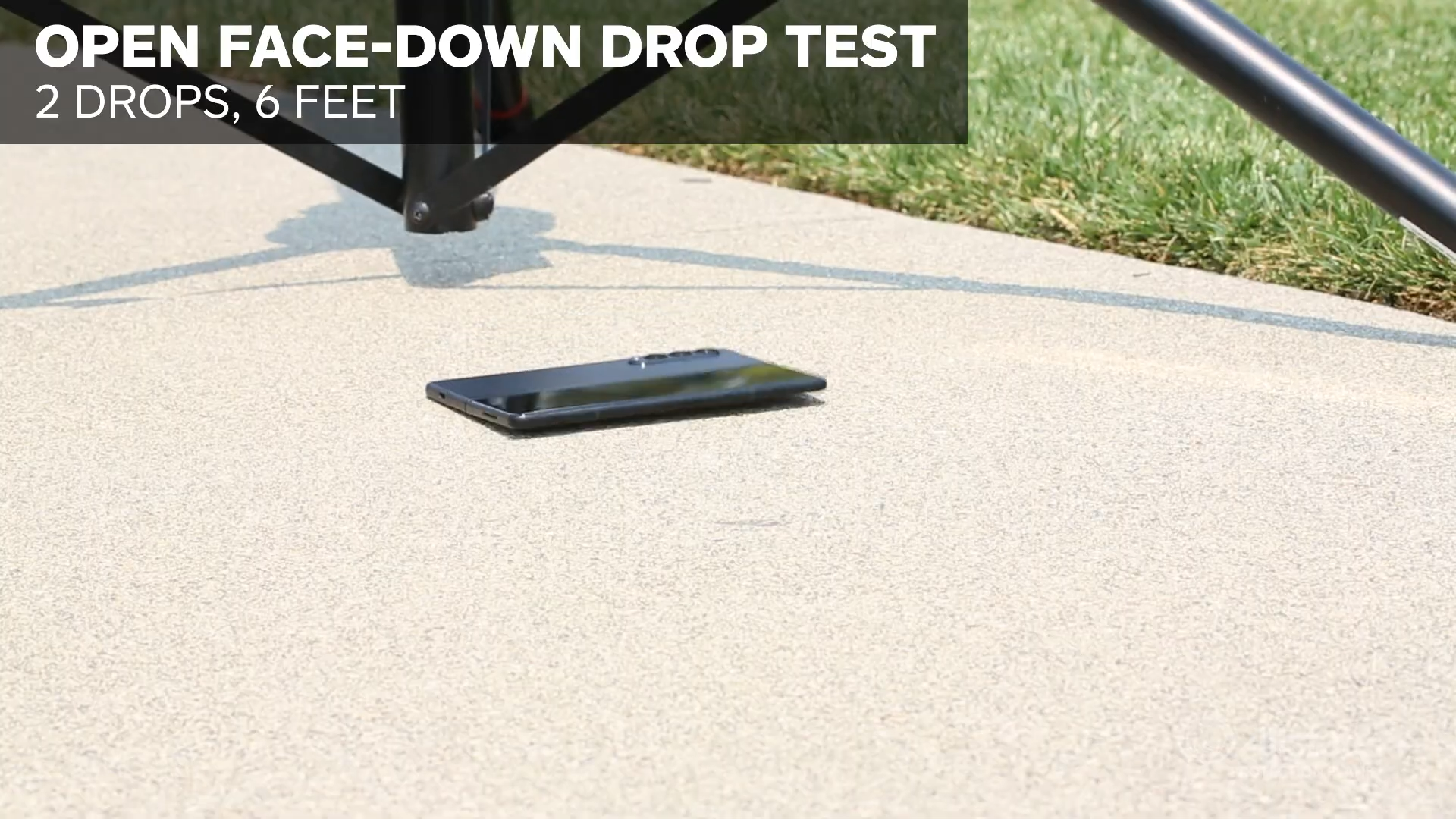
Getting a little more superficial, the aesthetics of the phone are virtually unchanged. The rear camera array shifts to a slimmer oval camera bump, a huge improvement over the expansive rectangle on the back of the Galaxy Z Fold 2. The left side of the phone features the same prominent glossy hinge with the Samsung logo at its center.
Rotating to the front, you have the Gorilla Glass Victus cover display with a centered hole-punch camera. The cover display is nearly bezel-less, with the exception of the left edge, which serves as the attachment point for the hinge. When folded, the right side of the phone contains the micro-SIM slot on the top half, while the volume rocker and power button with its built-in fingerprint sensor are on the bottom.
Unfolding the phone, there is only one notable difference from last year’s model and that is the under-display camera centered on the right half of the display. In use, it is preferable to a hole-punch camera because it is slightly less obtrusive, but I stress slightly in most circumstances. When it is displaying darker colors, it still looks like a hole-punch camera and lighter colors reveal a strong mosaic pattern over the top. It’s at its best when depicting a blend of colors as that masks the mosaic effect.
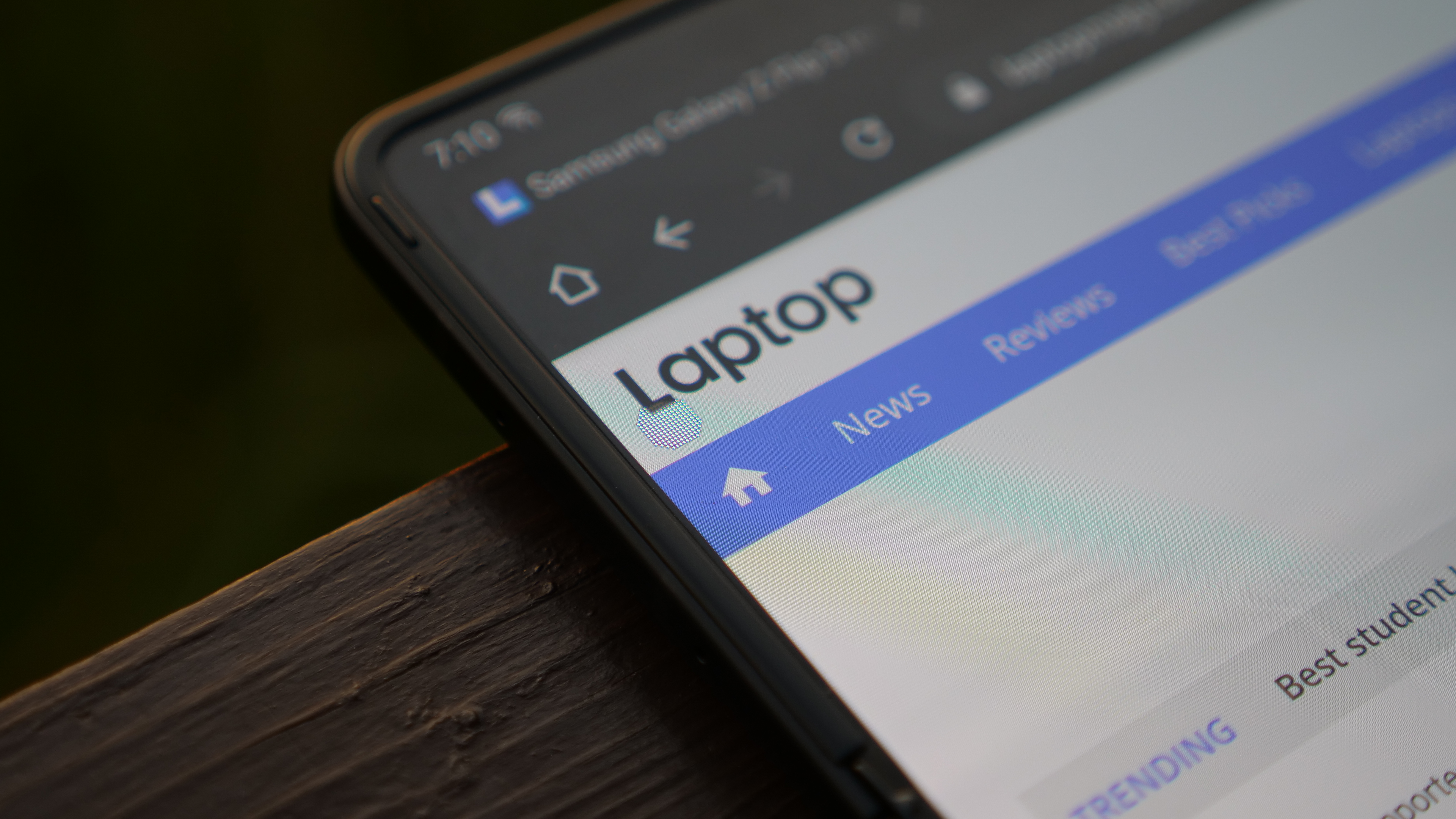
The other changes to the interior display are imperceptible, but arguably far more important. Particularly the claimed 80% improvement to its durability that comes from the new PET film combined with the improved display layer. The second predominantly impacts mourning Note fans as the Galaxy Z Fold 3 joins the Galaxy S21 Ultra with support for the S Pen. Just don’t use an old S Pen on it; you need the new S Pen Fold or S Pen Pro.
The unique form factor of the Galaxy Z Fold 3 makes size comparisons with most other phones a bit irrelevant, but in its folded state, it is 6.2 x 2.6 x 0.62 inches, and unfolded it is 6.2 x 5 x 0.25 inches. Either way, it is a hefty 9.55 ounces. That makes even the gargantuan Galaxy S21 Ultra (6.5 x 3 x 0.35 inches, 8.1 ounces) seem like a dainty addition to your pocket.
The Galaxy Z Fold 2 is the only real comparison that matters, and there, the Galaxy Z Fold 3 is a very slight improvement. The height and width are unchanged, but the Galaxy Z Fold 3 is 0.04 inches thinner when folded and 0.02 inches thinner when unfolded. It also cut nearly half an ounce off the weight of its predecessor. That may not sound substantial, but I assure you any reduction to the size and weight of this phone is a blessing.
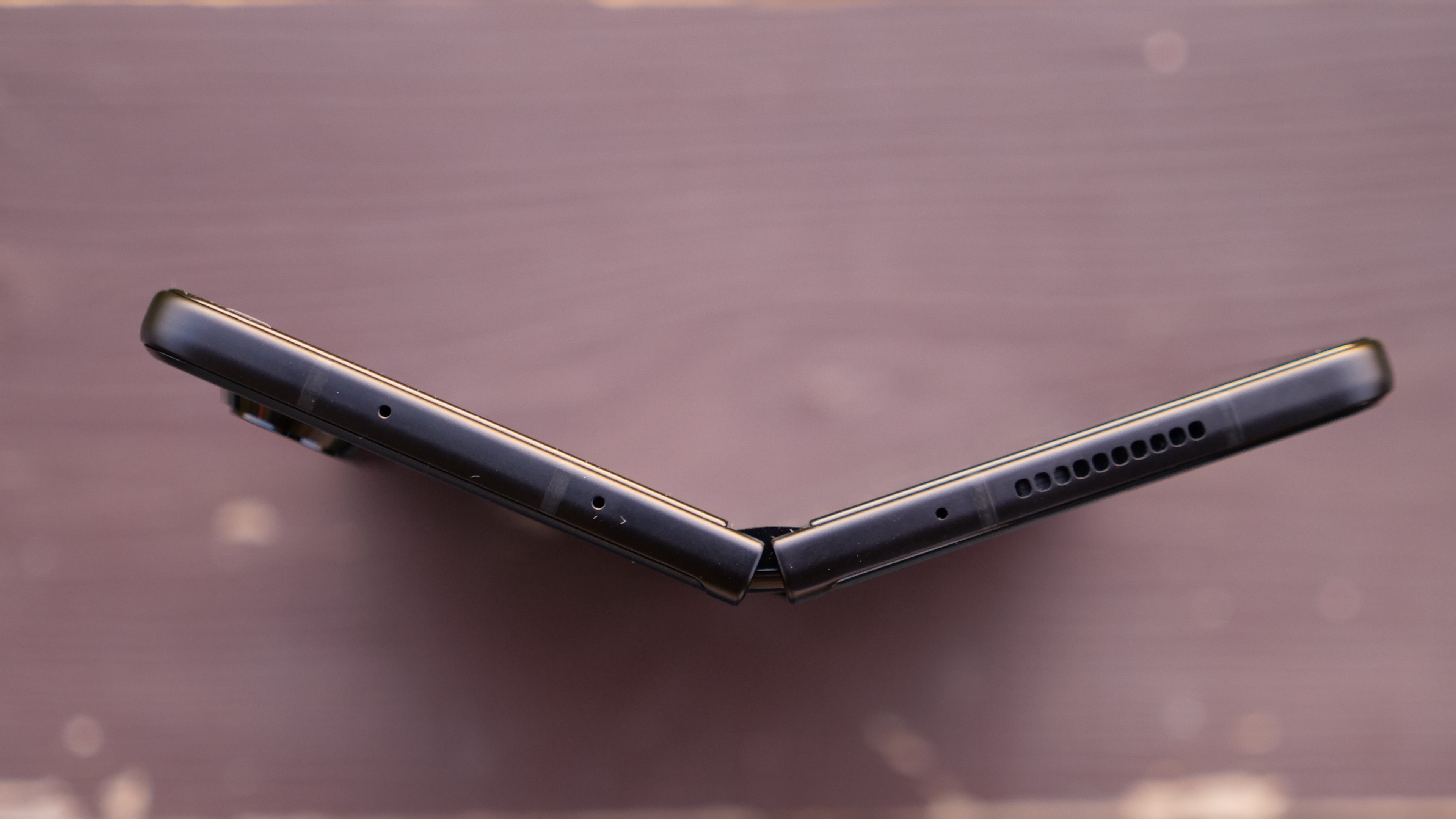
When you open the Galaxy Z Fold 3 to use in its full unfolded glory, it is a unique and wonderful experience. In my review of the Galaxy Z Fold 2, I said it’s the Android tablet that I never knew I wanted and that’s equally true for the Galaxy Z Fold 3. Unfortunately, in its folded state it’s less of a joy. The size and weight make it inconvenient to carry in a pocket even relative to other large flagships. The narrow cover display makes one-handed use acceptable, but it takes time to adjust to its odd folded dimensions.
I don’t want to oversell this problem, but it is something that you need to consider depending on your needs and habits. I use my phone to track my run every day and the Z Fold 3 is impractical for that, I would need to switch to using a smartwatch or fitness tracker. The Galaxy Z Fold 3 delivers a user experience that no other mainstream phone can match, but that doesn’t come without trade-offs.
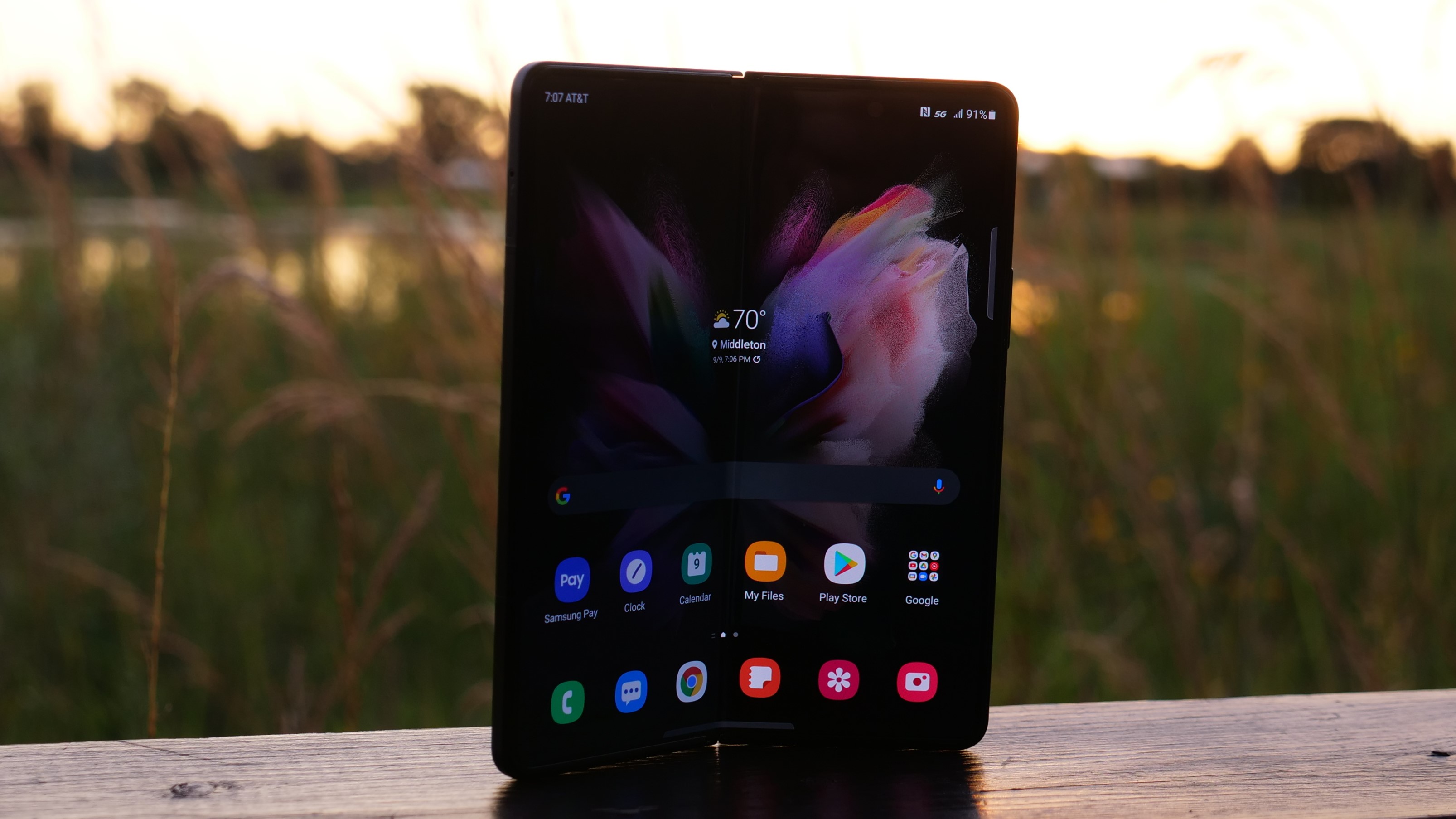
Samsung Galaxy Z Fold 3 displays
While the folding form factor may seem like the star of the Galaxy Z Fold 3, it’s more deserving of the best supporting feature award as it’s there to allow the displays of the Galaxy Z Fold 3 to really shine.
The cover display was basically an afterthought on the Galaxy Fold, it got a massive upgrade last year to a nearly bezel-less 6.2-inch, Super AMOLED display, and this year, it takes another leap adding a 120Hz refresh rate and an improved 2268 x 832-pixel resolution. For taking calls, checking notifications and other quick tasks, it is great. When you want to do anything more in-depth, you will turn to the internal display.
The 7.6-inch, Super AMOLED internal display looks just as amazing as it did last year. Visually, it is almost completely unchanged with a 2268 x 1768 pixel resolution and a 120Hz refresh rate. As I addressed in the previous section, the crucial changes to this display are all invisible with the addition of S Pen support and dramatically enhanced durability. While the cover display lagged in a couple of regards last year, both are now up to flagship standards.
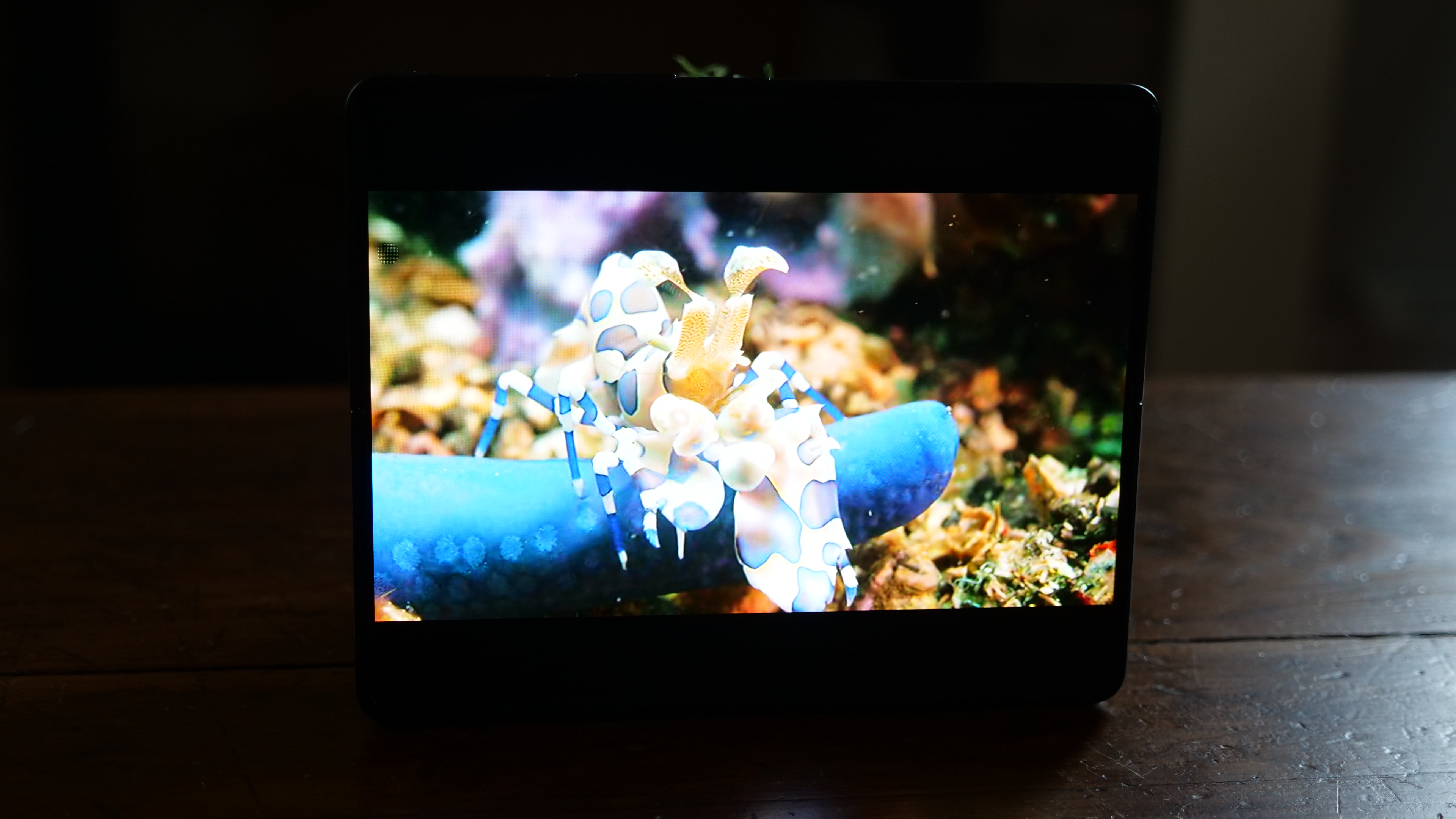
As I addressed in the previous section, the crucial changes to this display are all invisible with the addition of S Pen support and dramatically enhanced durability. While the cover display lagged in a couple of regards last year, both are now up to flagship standards.
I watched an episode of “Our Planet” on Netflix as the expansive internal screen with HDR support is a perfect match for the vibrant cinematography. The only quibble you can have with the Galaxy Z Fold 3 for video is the aspect ratio means you get significant bars at the top and bottom, but the image itself is fantastic. Watching a light yellow crab with an irregular blue pattern and diaphanous claws scramble over what appears to be a rich blue tentacle on the seafloor is a feast for the eyes with flawlessly sharp detail and exquisite colors.
Our lab testing was limited to the display’s Natural mode, which doesn’t show its full capabilities, but the Samsung Galaxy Z Fold 3 reproduced 76.9% of the DCI-P3 color gamut on its internal display and 75.8% on the cover display. The OnePlus 9 Pro (84.9%), iPhone 12 Pro Max (84.8%) and Samsung’s Galaxy S21 Ultra (81.4%) all topped these marks. However, in its vivid mode, the display likely nearly doubles that score as we’ve seen with every Samsung phone display in the past.
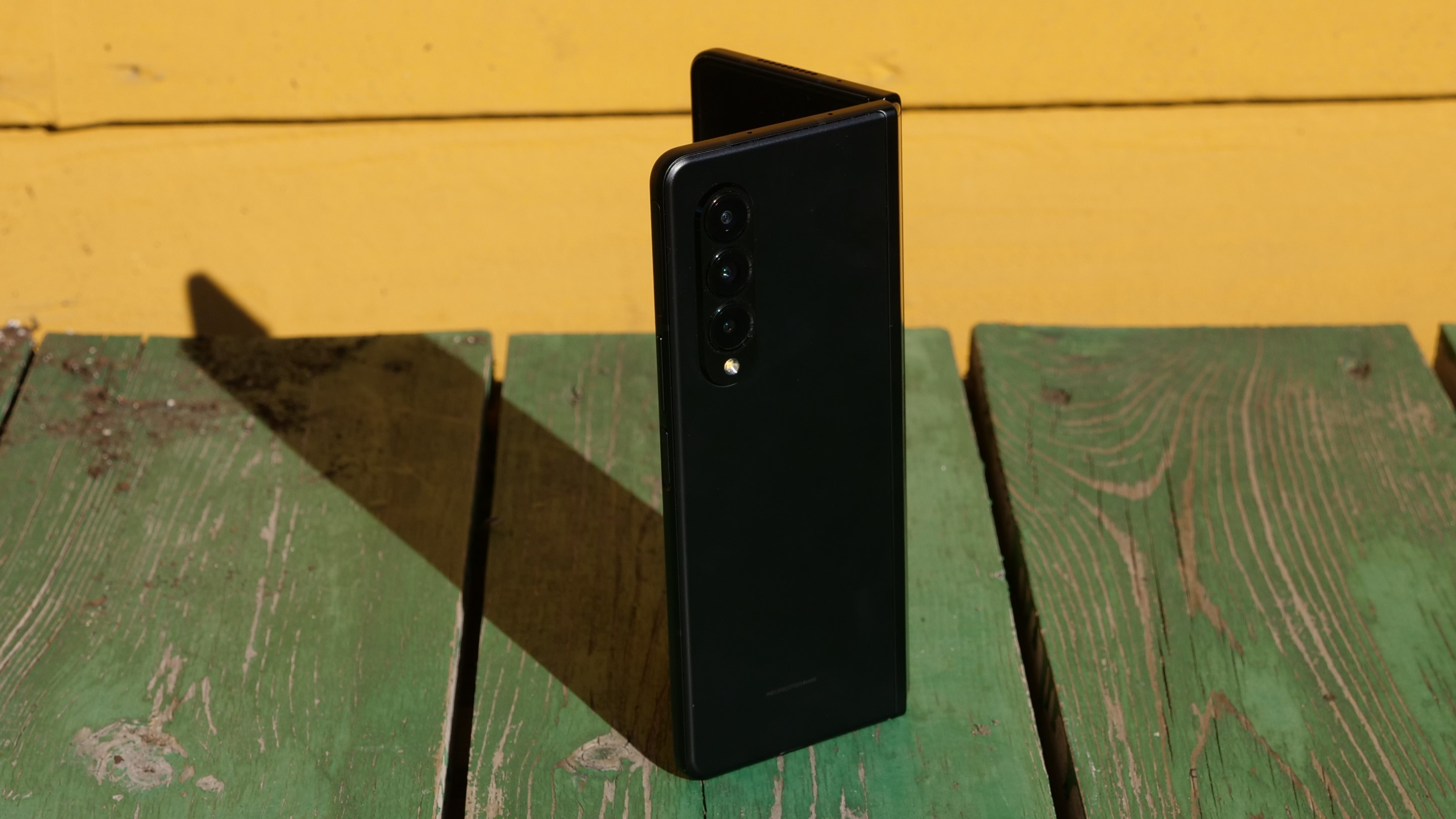
The Delta-E color accuracy test results (lower is better) were strong for the Samsung Galaxy Z Fold 3, with the internal display managing a 0.24 and the cover display a 0.26. That is behind the OnePlus 9 Pro (0.20), but considerably better than the Samsung Galaxy S21 Ultra (0.35).
Samsung Galaxy Z Fold 3’s internal display doesn’t crush the competition on brightness, but it is among the best, hitting a peak of 739 nits of brightness in our testing. That outshines the OnePlus 9 Pro (722 nits) and the iPhone 12 Pro Max (655 nits), but is shown up by Samsung’s own Galaxy S21 Ultra (821 nits) which remains the brightest phone display that we’ve tested. The cover display doesn’t top out as high with a peak of 685 nits.
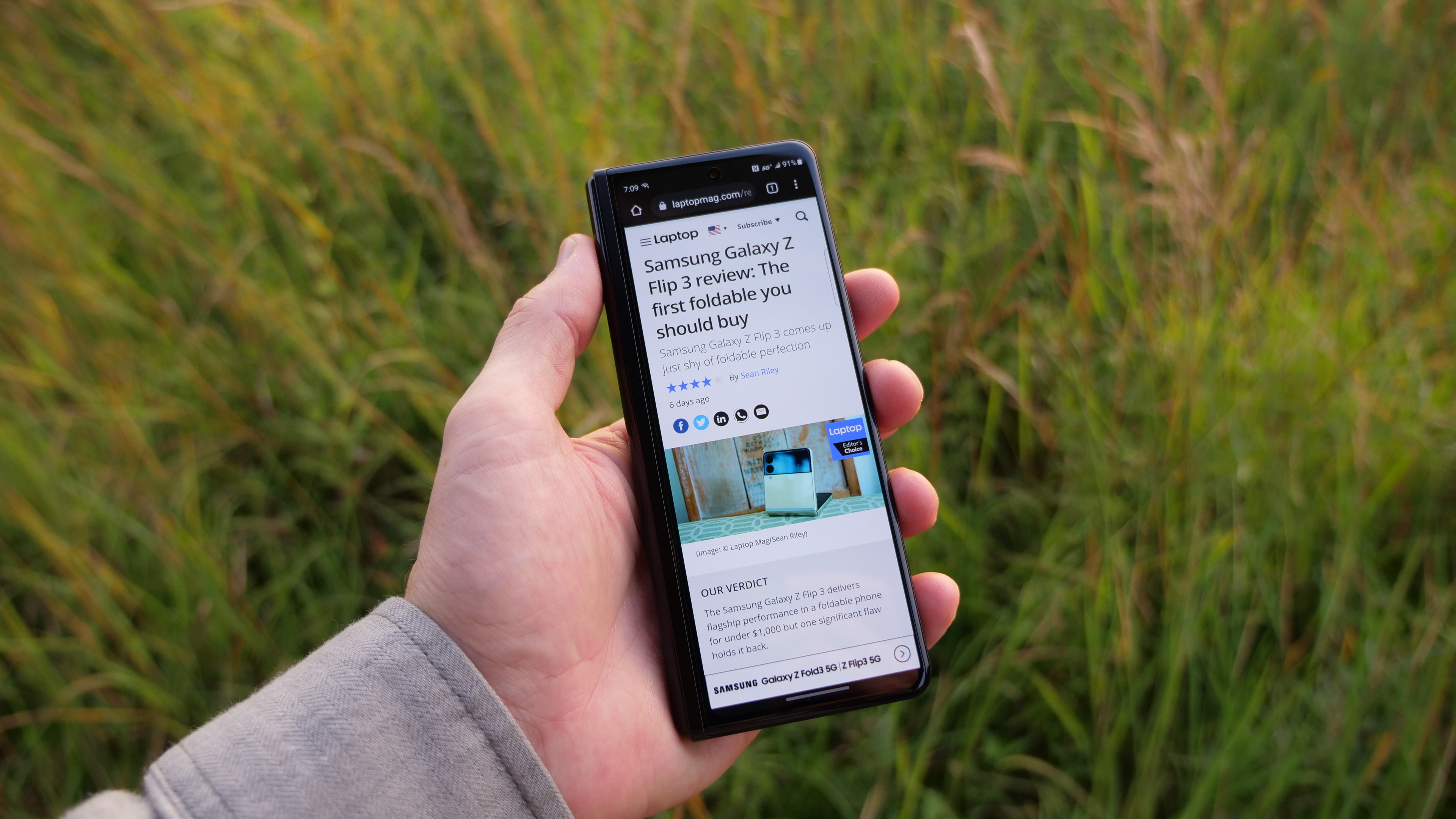
Samsung Galaxy Z Fold 3 performance
The Samsung Galaxy Z Fold 3 doesn’t skimp on its internals; the Qualcomm Snapdragon 888 is excellent, and its 12GB of RAM only falls short of the top-tier Galaxy S21 Ultra and some gaming phones. Even the base 256GB storage tier should be enough for the vast majority of users. If you’re a prolific photographer or videographer, you will likely need to look into a cloud photo backup — even if you upgrade to the 512GB model.
The Snapdragon 888 has recently been surpassed by the Snapdragon 888+, but that doesn’t make it any less powerful. I loaded up a couple of dozen Google Chrome tabs while running a YouTube video in the background without any slowdowns. The Galaxy Z Fold 3 lets you take this a step further, running three apps simultaneously. Scrolling on YouTube, Samsung Internet and Facebook remained smooth.
The Galaxy Z Fold 3 received a Geekbench 5 multi-core score of 3,418, which isn’t breaking any new ground, but is easily among the top available today. It is narrowly behind the Galaxy S21 Ultra (3,440), but more handily beaten by the OnePlus 9 Pro (3,685) and the iPhone 12 Pro Max (4,111).
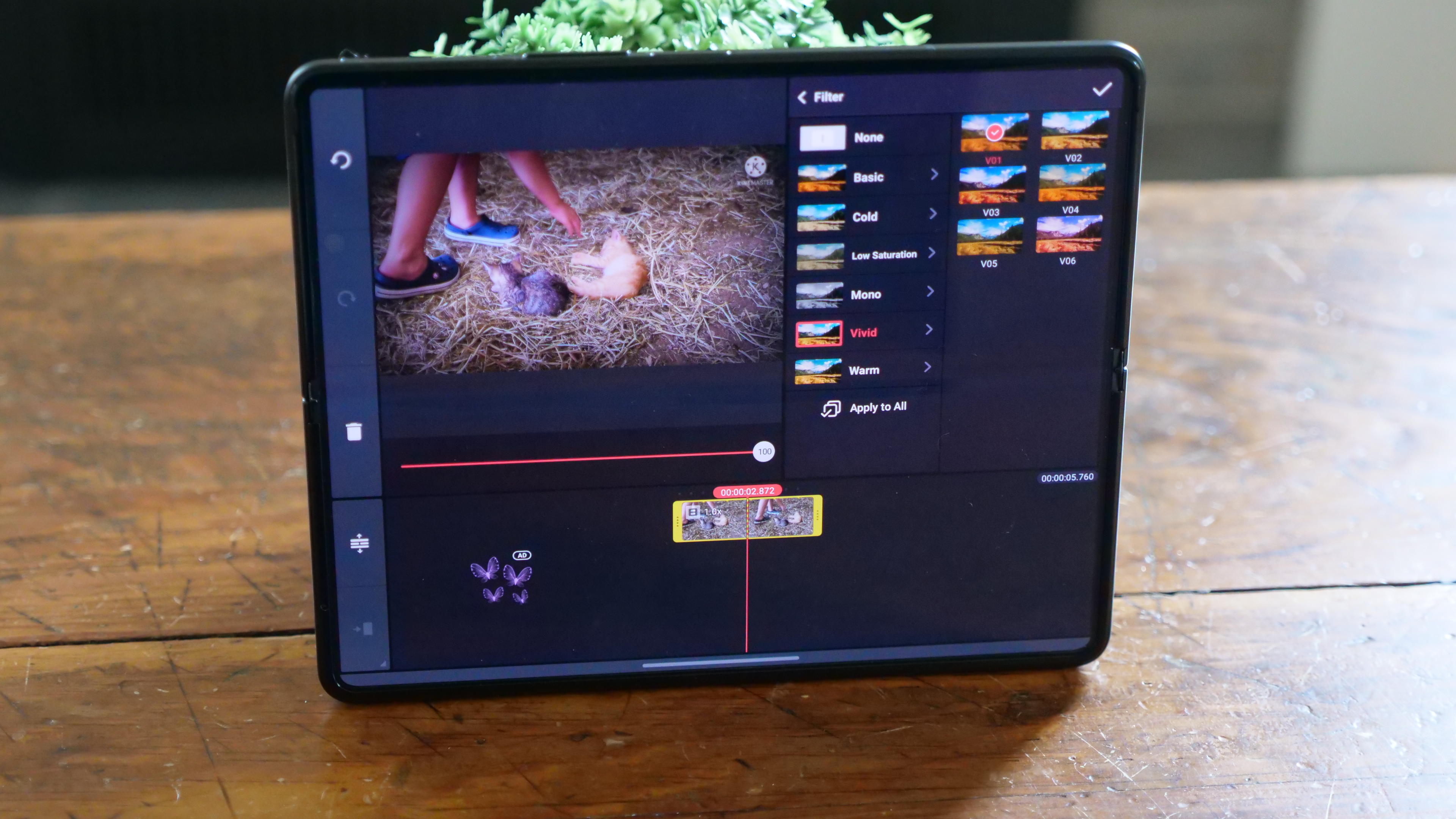
Graphics benchmarks were similarly solid for the Samsung Galaxy Z Fold 3, falling just short of the top Android flagships. It managed 34 frames per second in the Wild Life Unlimited 3DMark test. Finishing narrowly behind the OnePlus 9 Pro (35 fps), matching the Galaxy S21 Ultra (34 fps), and of course well behind the iPhone 12 Pro Max (54 fps).
While it is most true for Apple’s Bionic processor, the truth is that the current top-end Snapdragon chipset is also more powerful than is necessary for any current smartphone apps. The Galaxy Z Fold 3 may not top its competition, but it doesn’t need to, there is nothing that you will try to do with this phone where you will feel hampered by its performance.
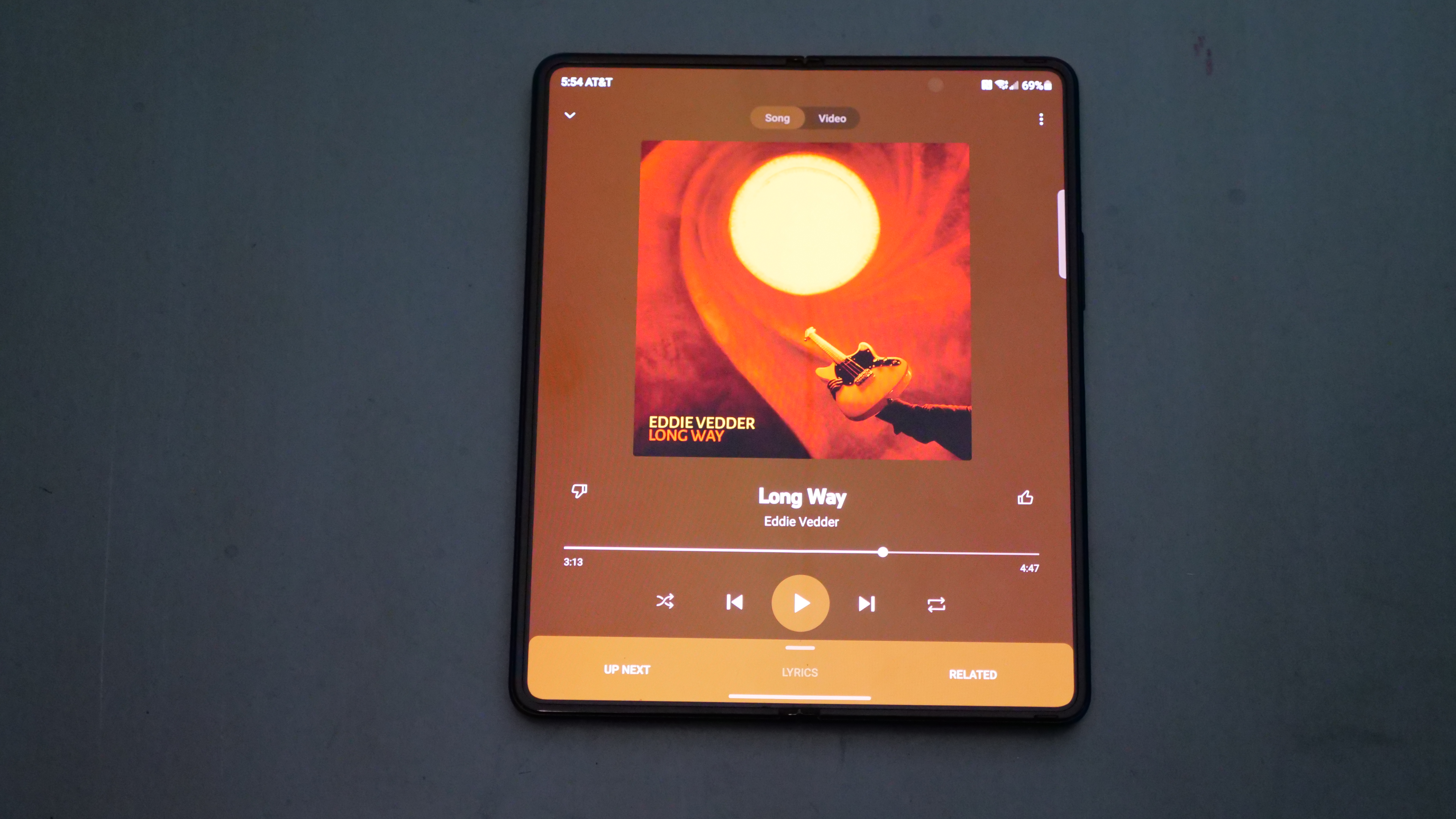
Samsung Galaxy Z Fold 3 audio
The Samsung Galaxy Z Fold 3 has stereo speakers located at the top and bottom of the phone and Dolby Atmos support. Samsung’s flagships have been on a roll with audio over the last year and the Galaxy Z Fold 3 is no exception.
I listened to Eddie Vedder’s “Long Way,” and the Galaxy Z Fold 3 speakers easily filled my 12 x 18-foot listening space. The gravelly vocals of Vedder were crisp and the laid-back, melancholy tune doesn’t draw attention to the weak bass performance of the speakers.
If you favor music with more of a bass punch, then invest in a pair of wireless headphones. However, for watching the occasional video on Netflix, YouTube or TikTok, or just adding a little background music in a pinch, the Galaxy Z Fold 3 is up to the task.
Samsung Galaxy Z Fold 3 battery life and charging
Battery life on the Samsung Galaxy Z Fold 3 is a little confusing as the delta between my experience and our Laptop Mag battery test is significant. The 4,400mAh battery isn’t massive given its 120Hz displays and performance capabilities, so it wouldn’t be surprising if it was a little short on battery life.
That’s what our lab tests showed. With the phone continuously web surfing at 150 nits on cellular, it lasted for 6 hours and 36 minutes on the internal display set to its Adaptive 120Hz mode. Switching to 60Hz, it jumped up to 7 hours and 53 minutes. As you would expect, the smaller cover display fared better making it to 7 hours and 58 minutes at its Adaptive 120Hz mode and 8 hours and 48 minutes when locked to 60Hz.
All of these pale in comparison to its competitors like the OnePlus 9 Pro (11:44), the Samsung Galaxy S21 Ultra (11:25) and the iPhone 12 Pro Max (10:53).
While that would lead you to believe that the Galaxy Z Fold 3 would have trouble lasting you through a day, that hasn’t been my experience with the device. This could be due to a variety of factors. I’m not using the internal display 100% of the time, I’m on Wi-Fi for the majority of the day, and the cell network in my area may be less congested than our test tab’s so my phone isn’t hunting for or using the more power-hungry cellular connection.
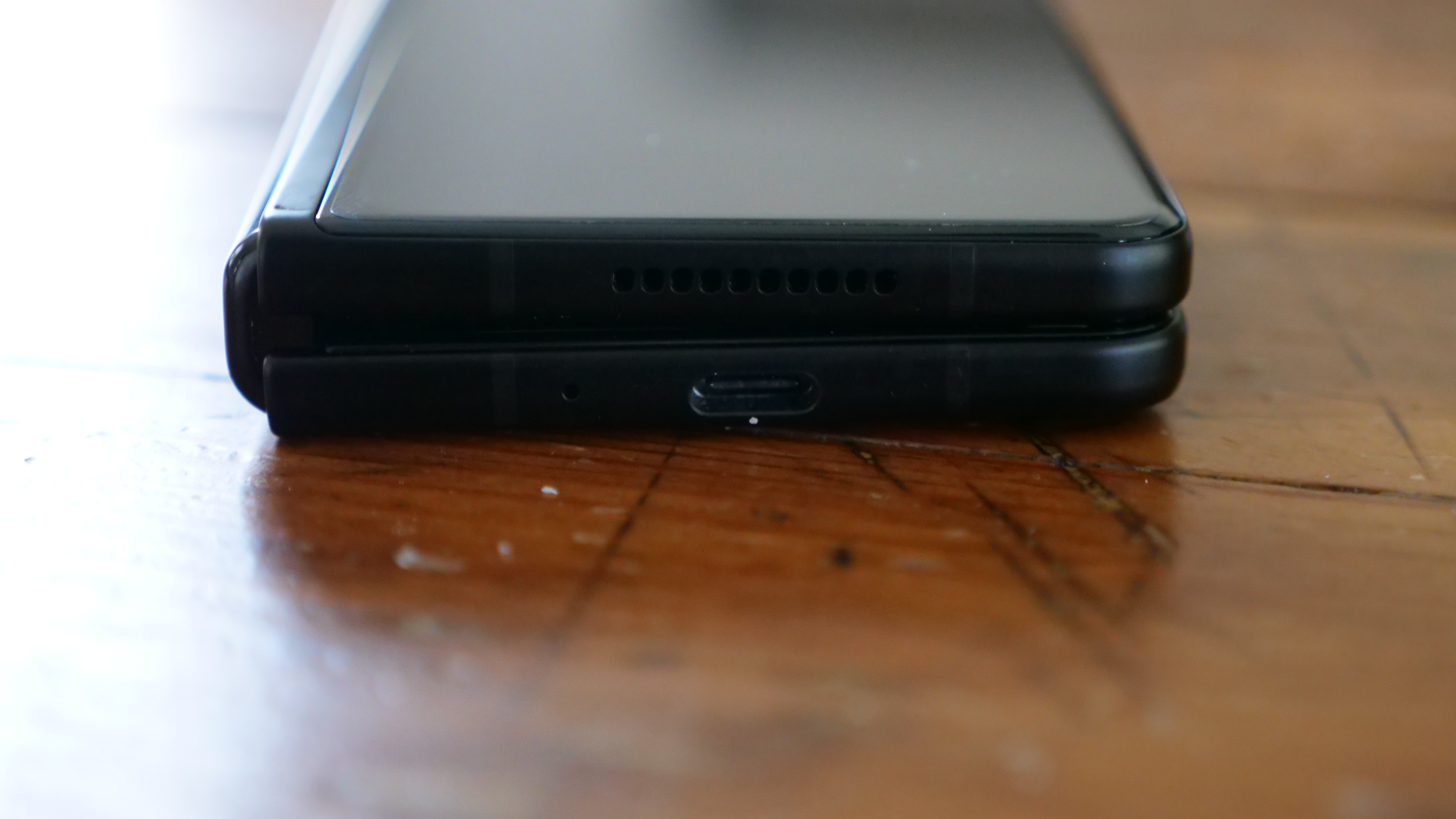
The end result is that I never once had battery concerns with the Galaxy Z Fold 3. My typical day with a phone runs from 7:30 a.m. to 10:30 p.m. with me running Netflix and/or YouTube streaming on Wi-Fi for roughly two hours, web browsing, using social media, gaming for about 30 minutes and capturing photos and videos. The lowest I ever managed to get with that routine was 35% remaining at the end of the day. I even tried to push the screen on time during one of my testing days and I hit 10 hours of screen on time with 20% battery life remaining.
I have no doubt you can burn through the Galaxy Z Fold 3 battery in a day if you are gaming or watching video on the internal screen for hours with the brightness set to full, but I do not think it will be a concern for the vast majority of users.
The Galaxy Z Fold 3 supports up to 25W fast charging, although as with Samsung’s other flagships, you don’t get a charger in the box. Using our own 25W charger, it reached a 24% charge in 15 minutes and 47% charge in 30 minutes. It’s no OnePlus 9 Pro, which hits a full charge in 30 minutes thanks to its bundled 65W Warp Charger, but it’s not bad either. The Galaxy Z Fold 3 also supports fast wireless charging at up to 15W.
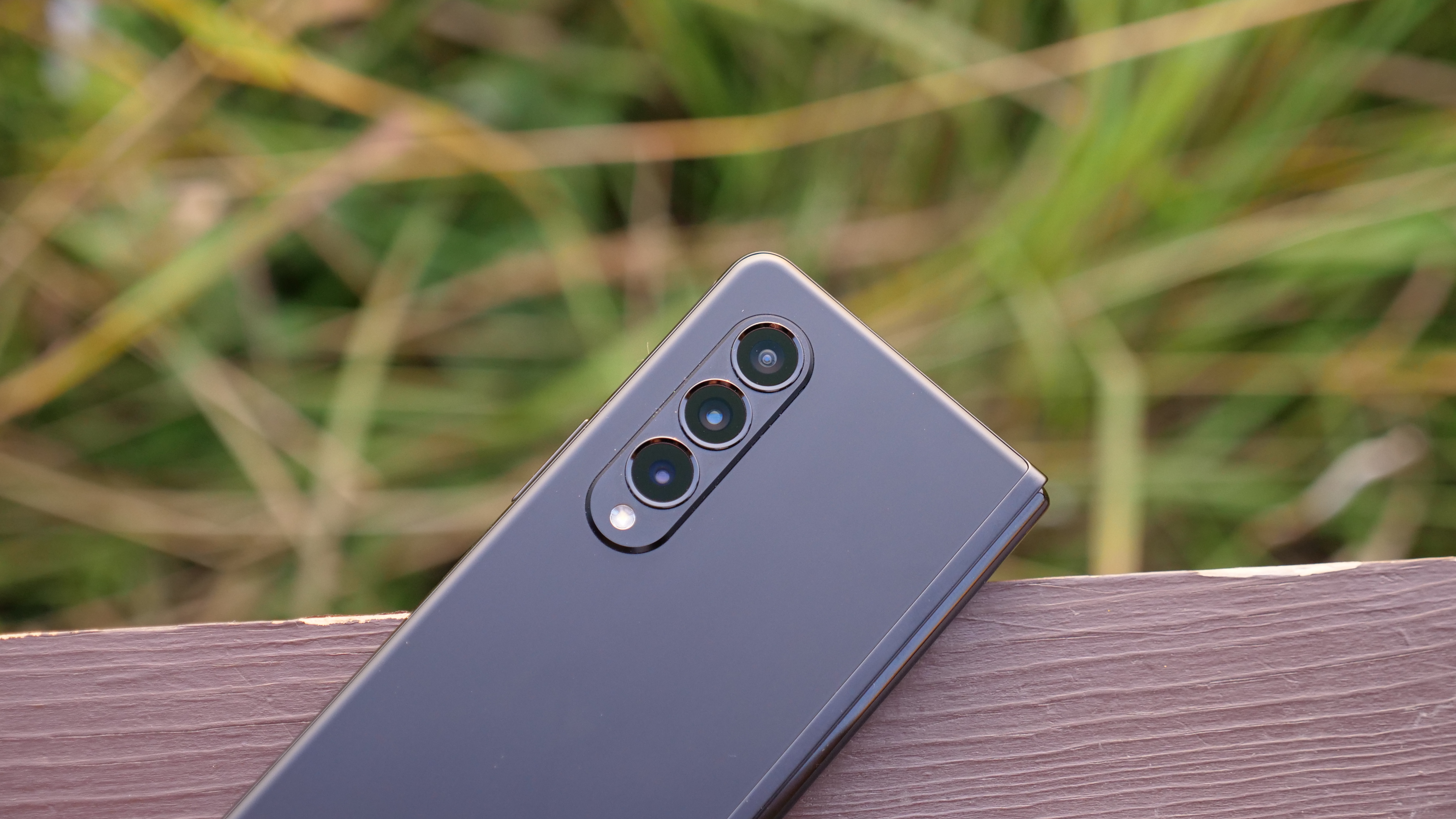
Samsung Galaxy Z Fold 3 cameras
The Galaxy Z Fold 3 doesn’t deliver the eye-popping, high-megapixel main camera of some other Samsung flagships, but the results from its triple-camera array are still superb. All three sensors are 12MP, there’s a primary wide-angle at f/1.8, an ultra-wide at f/2.2 and a telephoto at f/2.4 with a 2x optical zoom.
It isn’t up to the standard of the Galaxy S21 Ultra, which may not be what you want to hear about your $1,799 phone. However, I do not think the resulting images will disappoint.
Here’s a sampling of shots from the primary lens both at 1x and 2x zoom. The sharp detail from this sensor is remarkable, in the shot of the two barn kittens that I was tempted to adopt, the fine whiskers of both cats come through perfectly and their soft green eye color pops against their fur.

Samsung Galaxy Z Fold 3 wide-angle

Samsung Galaxy Z Fold 3 wide-angle

Samsung Galaxy Z Fold 3 wide-angle

Samsung Galaxy Z Fold 3 wide-angle
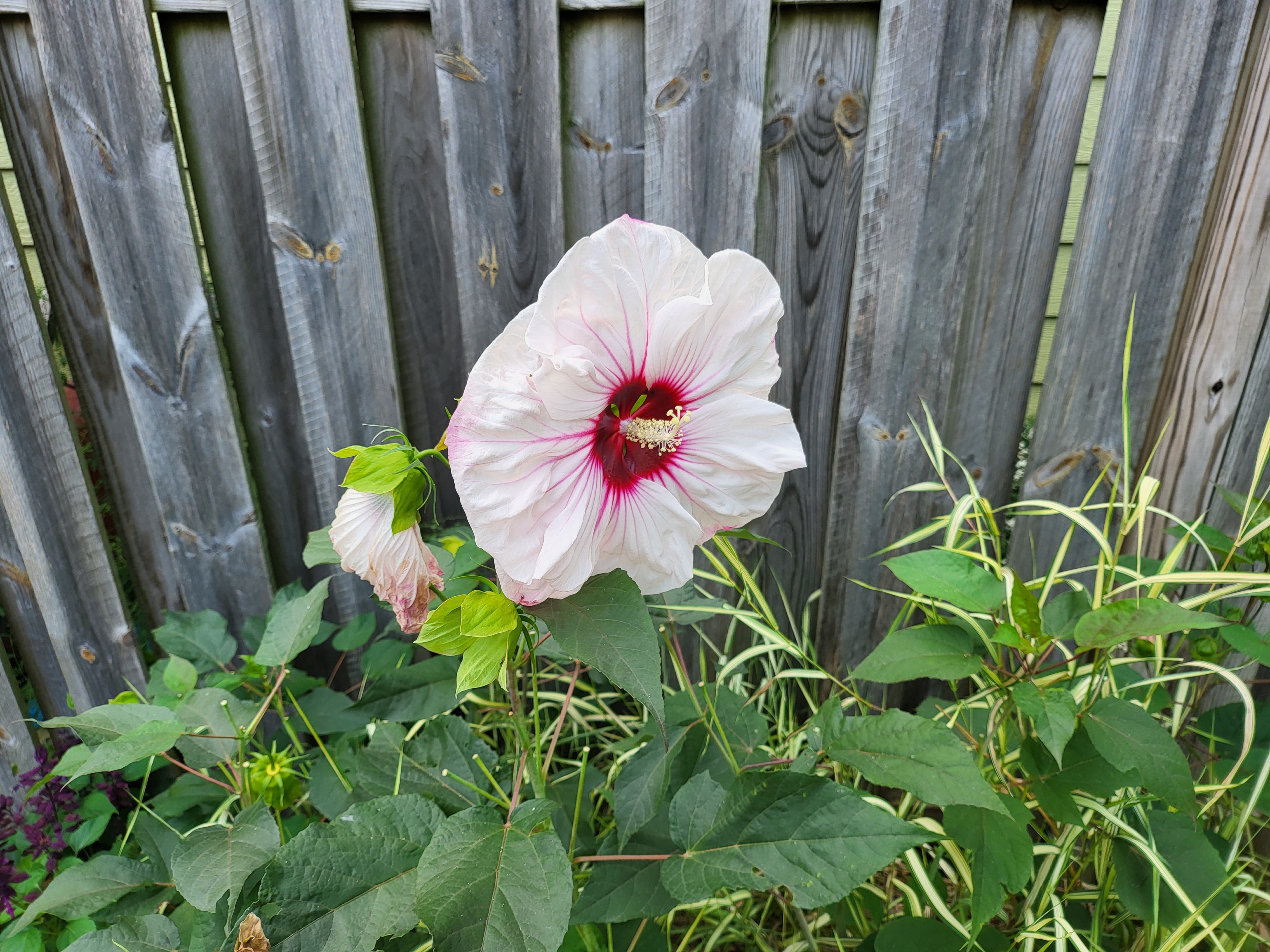
Samsung Galaxy Z Fold 3 wide-angle

Samsung Galaxy Z Fold 3 wide-angle
The ultra-wide camera matches the color and detail of the primary and like the Galaxy Z Flip 3, it mostly dodges the edge distortion that can be typical in ultra-wide sensors. My typical shot of the mural on a nearby restaurant shows little distortion in either the building or the traffic lights nearby, which can warp inwards if the software doesn’t handle the image properly.

Samsung Galaxy Z Fold 3 ultra-wide
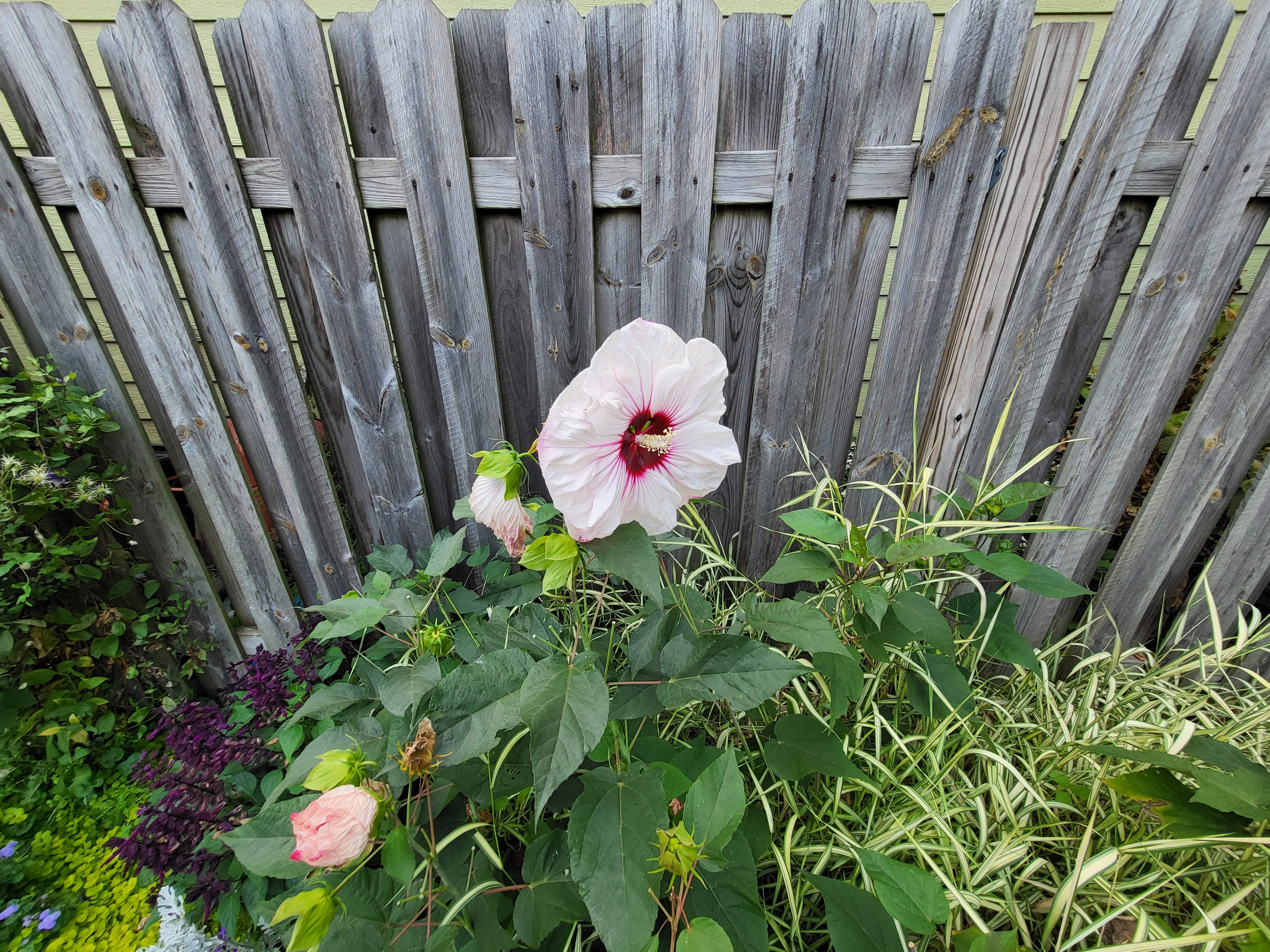
Samsung Galaxy Z Fold 3 ultra-wide
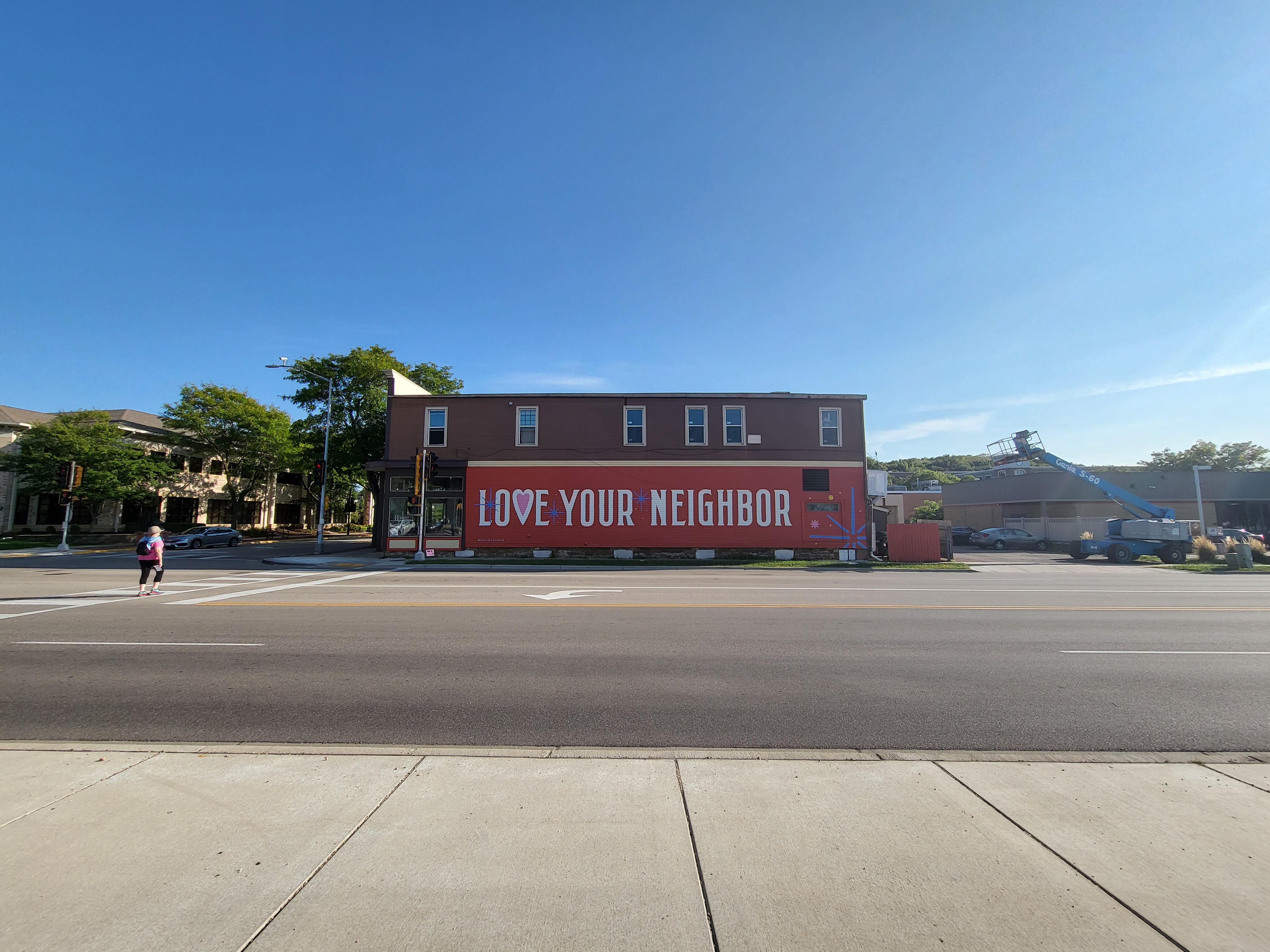
Samsung Galaxy Z Fold 3 ultra-wide
Turning to the telephoto, while a 2x optical zoom isn’t much, it is still preferable to no telephoto at all. It also makes the digital zoom to 10x almost entirely usable, there’s some definite drop-off in quality around 5-6x. But that’s enough reach that if you are trying for photos of a kids sporting event, a nearby animal, or just a distant building that you might get a shot that would otherwise just be lost.

Samsung Galaxy Z Fold 3 telephoto 2x

Samsung Galaxy Z Fold 3 telephoto 2x

Samsung Galaxy Z Fold 3 telephoto 10x
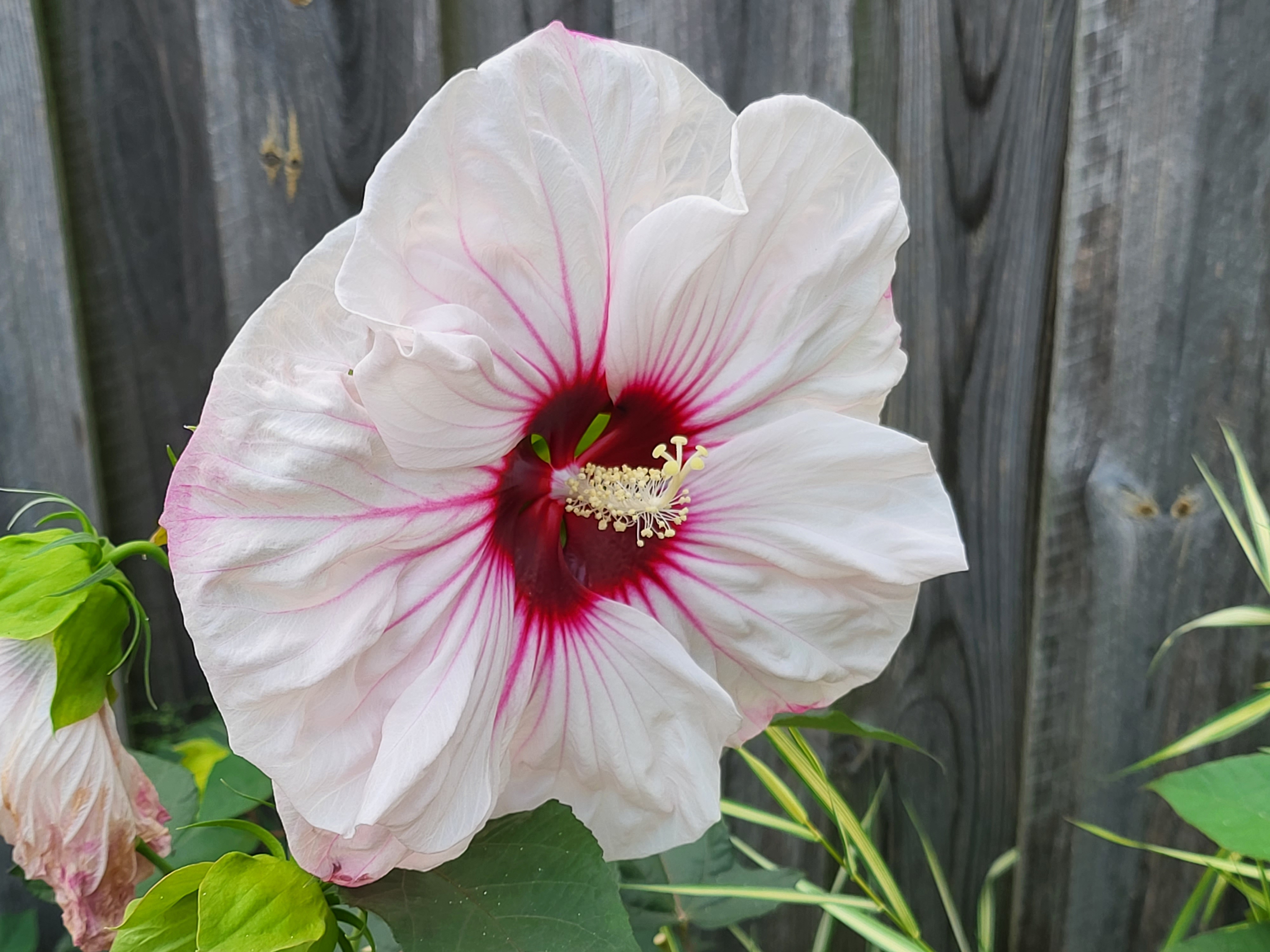
Samsung Galaxy Z Fold 3 telephoto 2x
The front-facing hole-punch camera is a 10MP sensor with an f/2.2 aperture. It gives you a pair of zoom options and the portrait mode held up well in my testing. This is not to be confused with the under-display camera on the internal display, which is a 4MP at f/1.8. I cannot stress enough that this should not be used to take selfies. I am convinced that Samsung intended this purely to be used for video calling and for that it is absolutely fine, but as you can see in the sample photos below, it doesn’t begin to hold up to modern standards for photos.

Samsung Galaxy Z Fold 3 front-facing camera

Samsung Galaxy Z Fold 3 front-facing camera wide-angle

Samsung Galaxy Z Fold 3 front-facing camera portrait mode

Samsung Galaxy Z Fold 3 front-facing camera portrait mode wide-angle
Samsung Galaxy Z Fold 3 software
The Samsung Galaxy Z Fold 3 runs Android 11 with Samsung’s One UI 3.1. Despite my typical preference for the near-stock Android experience with the Pixel, Samsung has a number of legitimately useful software extras for its foldables.
Flex mode is one of these features. This gives you a split-screen experience in apps when you have the screen folded partially. The built-in camera app makes handy use of this as you can set the phone down folded up and you get to see the controls and snap a photo with the phone serving as its own tripod. For low-light photos, this is a huge advantage as it doesn’t need to deal with any handshake.
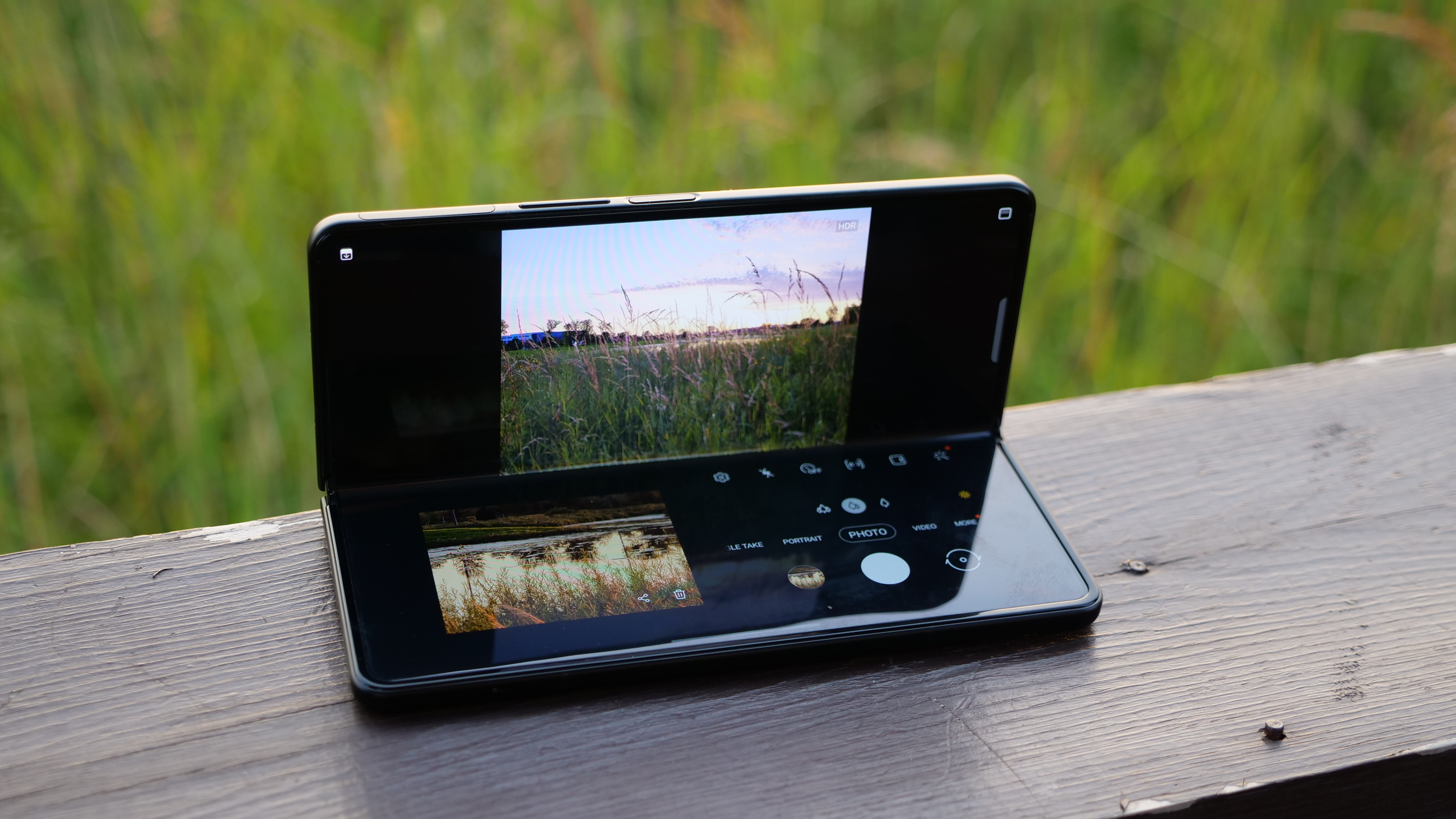
Multitasking is also unmatched on the Galaxy Z Fold 3. While as I previously mentioned you can run three apps at once, that’s mainly good as a “look what I can do” feature, but the two-up multitasking with a full app on each side or at the top and bottom is brilliantly useful. Watch YouTube on one side while you scroll through an article on the other or run a video call while you have a messaging app open below.
The other brilliant new feature is the Taskbar, which gives you a glanceable view and the ability to quickly switch to your favorite apps (or a favorite set of apps with the ability to pin a pair of apps to launch them simultaneously).
Samsung also remains the best in the Android world when it comes to software updates with security updates for four years and three years of major OS updates. Particularly for a $1,799 phone, it’s nice to know that you won’t be abandoned in a couple of years.

Bottom line
The Samsung Galaxy Z Fold 2 is one of my favorite phones ever and the Galaxy Z Fold 3 improves on it. The addition of water resistance and the improved screen and chassis durability are all huge steps forward for a phone that felt a bit like handling fine china in the past. The Galaxy Z Fold 2 avoiding any serious durability concerns and the improvements to the Galaxy Z Fold 3 should instill confidence that this phone can hold up to daily use.
There are still drawbacks to its unique design though. The chunky form factor when it is closed is irritating at times and a complete non-starter as a phone to take with me running.
I’m an admittedly light tablet user, but I do have an iPad that I use around the house and a Kindle that I read on at night, and the Galaxy Z Fold 3 easily fills both of those roles for me, which helps to justify its exorbitant cost. The $1,799 price point is an improvement, but it needs to come down another $200 to be vaguely competitive with the top-tier flagships.
If you are a person that wants one device to rule them all, and are willing to pay for it, the Galaxy Z Fold 3 is worth the price of admission. However, unless money is no object, I think most would still be happier with the Galaxy S21 Ultra or iPhone 12 Pro Max and several hundred extra dollars in their pocket.
Sean Riley has been covering tech professionally for over a decade now. Most of that time was as a freelancer covering varied topics including phones, wearables, tablets, smart home devices, laptops, AR, VR, mobile payments, fintech, and more. Sean is the resident mobile expert at Laptop Mag, specializing in phones and wearables, you'll find plenty of news, reviews, how-to, and opinion pieces on these subjects from him here. But Laptop Mag has also proven a perfect fit for that broad range of interests with reviews and news on the latest laptops, VR games, and computer accessories along with coverage on everything from NFTs to cybersecurity and more.
